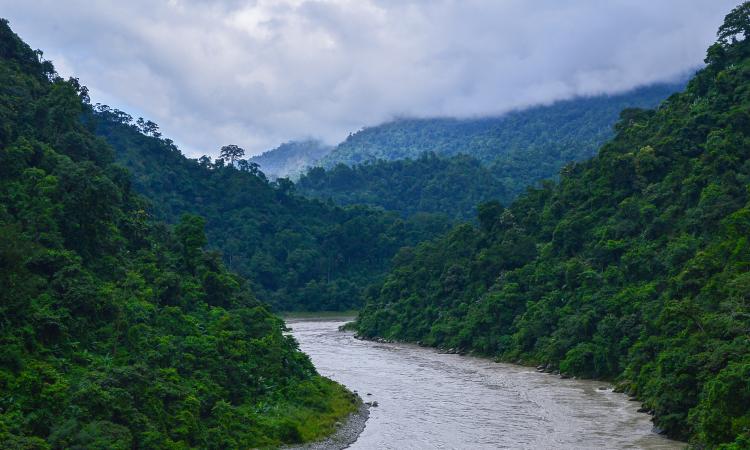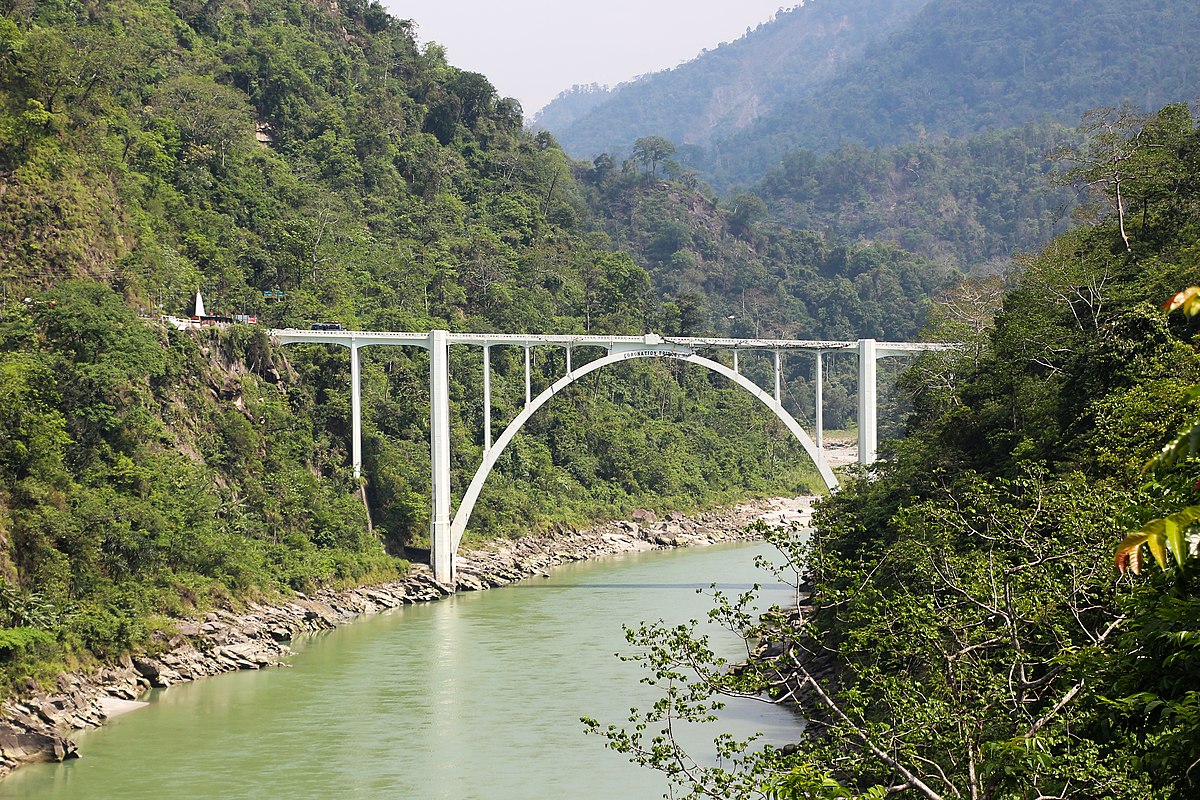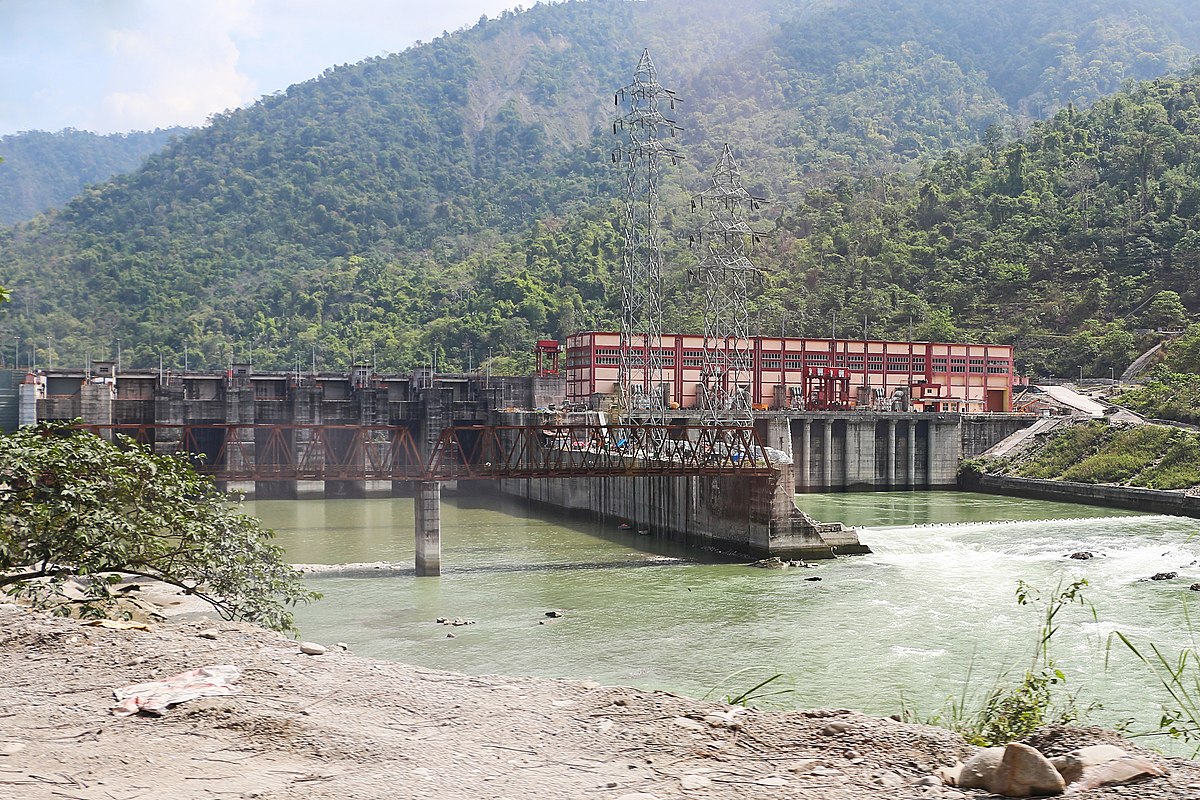
That corner of the country where Sikkim and North Bengal are situated is less than 80 km at its widest point. This region lies to the North-East of the “Chicken's Neck” or the strategic Siliguri corridor. Flanked by Nepal to the west and Bhutan to the east, this region is administratively divided into Sikkim and Bengal, and geographically by the mighty Himalaya to the North and the Terai-Duar plains to the South.
Throughout the year, the rains and the melting glaciers feed the streams in this hilly region. They join up to form rivers that gush downhill like excited children hurrying home from school. But when they hit the plains, they emerge as venerable ladies lazily meandering to cede into the Ganga – Brahmaputra system. The rivers in this part of India are unique, in that, they are all transboundary.
Even Mechi, the smallest one, flows along the India-Nepal boundary to join the larger Mahananda, and finally the Ganga. The Mechi has its origins in the Nepalese Himalaya, while the Mahananda trickles down from the Indian side of the mountains.
The majestic Teesta
However, the river which bestows a defining character to the region is undoubtedly the Teesta. It is said that this beauty begins her journey in India, at a height of over 7000 meters above sea level. Several glaciers feed this river which takes a 400 km long route through Sikkim and Bengal, before meeting with the Brahmaputra in Bangladesh. The Teesta’s flow varies significantly with the seasons. Flash floods usually occur in summers and continue into the monsoon. As winter sets in, the flow decreases significantly. In the hills, the Teesta flows rapidly cutting deep ravines and pulling boulders with it.

Several towns dot the river, but for most of her mountain journey, Teesta’s banks are protected by thick riparian vegetation. The higher altitudes are dotted with Rhododendrons, Oaks, Maples, and other broad-leaved trees that share the habitat with conifers such as the Himalayan Alpine fir, Sikkim Larch, Himalayan Hemlock, and a variety of pines, ferns, and orchids. The lowlands of Sikkim are home to the Great Hornbill, Tesias, Warblers, Flycatchers, Ibisbills, and Trogons. The Rufous-necked Hornbill used to be found here but has not been recorded for some time.
The astounding diversity of butterflies attracts wildlife enthusiasts from across the world. The Red Panda - the state animal of Sikkim – is highly endangered and receives the highest legal protection. The rich forests feed the Teesta with nutrients, which she will relinquish in the Terai-Duar valley.
Emerging from the hills, the Teesta hits the plains at Sevok, and bursts into a hundred braids. Her humble journey through the hills is overshadowed by her magnificence on the plains, as she dissects the landscape by her sheer breadth. It is only upstream of Sevok that the Teesta can be crossed, where the imposing ‘Coronation Bridge’ spans its narrow channel.

On the plains, the river spreads her organic matter and enriches the soil of the Duar valley. Her magnanimous ecological services and the rich fish diversity of the Teesta, make her the lifeline of this region. Over hundreds of years, the farmers of Duar valley have cultivated an astonishing variety of food. While much of this diversity is lost forever, even today, the subji mandis in Alipurduar town sell 14 types of brinjals, 10 varieties of potatoes, 7 different lemons, over 6 different bananas, and umpteen types of chilies.
The fertile Duar region has some well-protected areas like the Gorumara National Park, Senchel Wildlife Sanctuary, the Chilapata Forest, and the Buxa Tiger Reserve. The flora of this region is quite similar to that of the Deccan plateau. Amla, Peepal and Banyan share the forests with the Hirda (Terminalia chebula), Shirish (Albizia lebek), Semul (Bombax ceiba), Kinai (Albizia procera), Karmal (Dillenia pentagyna). The forests are interspersed with Sal (Shorea robusta) and Teak (Tectona grandis). Some unique species like the Duabanga or Bondorfulla (Duabanga grandiflora) and the Chilloni or Needlewood tree (Schima wallichii) are found in these parts.
The rich biodiversity of the Teesta - under threat!
However today, all is not well. Over time, Teesta’s alluvial bequest to the Duars has reduced significantly and so has the bounty of fish she carefully tended. A series of dams in the hills, and barrages on the plains have reduced the river into an economic resource. If this is not enough, the Teesta waters are being linked to the Mahananda and the Jaldhaka rivers. These interventions have annexed critical ecosystem services for purposes of irrigation and hydropower.
The structures have given rise to ecological and social problems, which span from Sikkim to Bangladesh. The dams in the mountains trap the nutrient-rich silt behind them, and this has led to a drop in the soil fertility of the Terai-Duar plains. Downstream of the Gajoldoba barrage, farmers have reported lower yields and noticed more sand, than silt being deposited by the waters of the Teesta.
Furthermore, since Independence, the spate of dam-building activity in the Himalayan rivers has arrested the supply of fertile silt to the Sundarbans. This delta faces continuous erosion by the sea and must be replenished with silt, to maintain its ecological productivity. As the amount of silt declines, the exceptional biodiversity in the Sundarban’s terrestrial, aquatic and marine habitats is threatened. This deficiency is sinking the Sundarbans and turning it into a veritable threat for human settlements in this region.

Dams unleash destruction
Unfortunately, the cost-benefit analysis of dams does not consider such far downstream ecological threats. The rising water levels behind the dams affects human settlements. Often, this leads to relocation of villages and loss of livelihoods. Before the dams were built, the communities along the Teesta indulged in subsistence farming, harvesting forest produce, fishing, gathering stones, gravel, and sand from the river, and other such activities for their living.
With the hydroelectric projects, this was to change. Their cultural connection with the river would stand to be disrupted. Gratuities like one-time compensation, relocation, or temporary jobs, were not worth considering for the communities which have, for hundreds of years, lived in harmony with nature in this adverse landscape.
Local communities have been in conflict in nearly every dam project in the world, and here too, the Lepcha community of Sikkim opposed the Teesta Hydroelectric projects. The ‘Affected Citizens of Teesta’ (ACT) group has been protesting against six mega-hydel projects in the Dzongu Lepcha Reserve. The ACT warns that these dams are threatening the rich biodiversity of this region, and will adversely affect the survival and livelihood of the Lepcha and other communities along the river.
In January 2021, the ACT reported several landslides, flash floods, and earthquakes after the construction of dams at Dikchu and Chungthang on Teesta. The Teesta basin is a critical region in the Indo-Myanmar biodiversity hotspot, and the dams are weakening the biodiversity. Furthermore, new construction activity also is a huge threat. Constructing new roads for transporting equipment, blasting and excavating material, tunneling for waterways are all catastrophic activities in the fragile Himalaya.
The Gajaldoba barrage in India and the Teesta barrage in Bangladesh create another ecological problem. These barrages impound water for irrigation. Downstream, the reduced flow creates large dry tracts of sand that are nearly devoid of fertile silt. The sun bakes them into hard islands, unsuitable for cultivation. In the monsoon, these tracts constrict the flow of the river and the swelling waters inundate the neighbouring fields. Every year crops are destroyed and farmers are being driven away from their farms.
During the non-flood period as the water level drops, most braids dry up while others turn shallow. The river can no longer sustain her fish populations. Moreover, the obstructions pose a formidable threat to the fish that go towards the source for breeding. Fishing communities have reported a significant drop in fish diversity and quantities. This has triggered the rise in Dighis or small ponds, where Rohu and Katla are cultivated. Such ponds are abundant in the towns of Coochbehar and Alipurduar.
India’s insatiable demand for electricity and the international push towards renewable sources means more hydroelectric dams in the Himalayan rivers. These dams are neither ecologically benign nor tolerant of local communities. By no stretch of imagination can their yield be classified as ‘clean’ energy. Furthermore, the impacts of dams are spatially and temporally dissociated. Hydropower, water availability, and land under irrigation increase in the short run.
Cities consume the additional power and water, while far away farms enjoy the irrigation. On the other hand, cultural significance weakens, soils lose their fertility, areas turn vulnerable to floods, and ecosystem productivity declines. These changes may take generations to show up and are never captured in national accounting. The economists cannot ‘see’ the socio-ecological damage in numbers.
A recent expert committee examined the role of 24 proposed hydroelectric projects in the Alaknanda and Bhagirathi basin. The committee concluded that 23 projects would have an “irreversible impact” on the ecology of the region. As more hydroelectric dams are planned, the mountain communities and the fishermen on the plains stand to lose their livelihoods. They are already being pushed to work in cities. Here they arrive without the skills needed for decent employment, and are relegated to menial work.
The Teesta is no longer the lifeline of the locals but has now morphed into an economic resource of national importance. Is this for better or worse? Should we produce more electricity at the expense of the Sundarbans and the marginalisation of the local communities? The British Raj introduced ‘development by exclusion’ to India, and today we roll in the same muck.
Dr Gurudas Nulkar is a professor and Head of Symbiosis Centre for Climate change and Sustainability, and a member of the board of Ecological Society. He is the author of several books on sustainable development